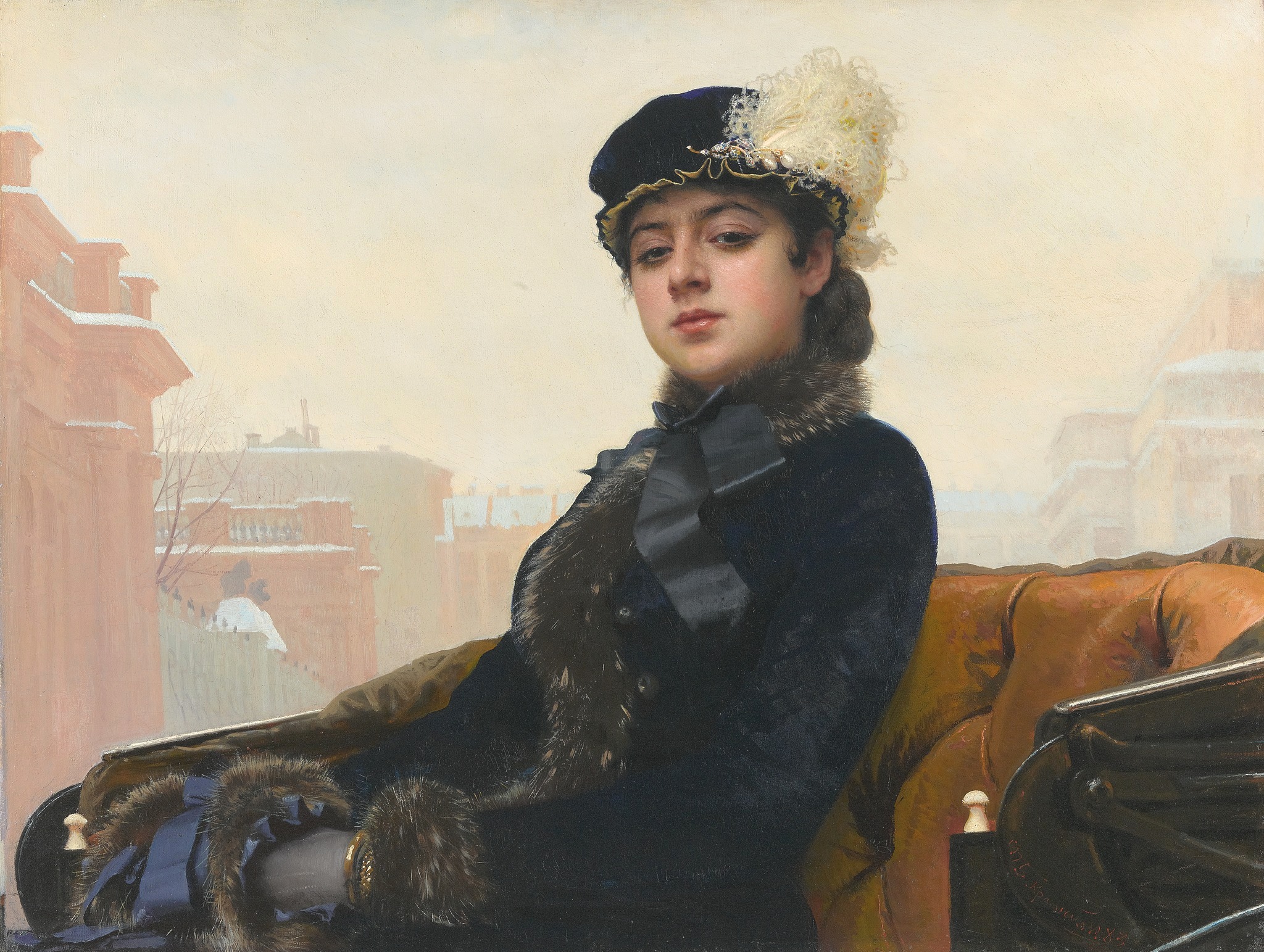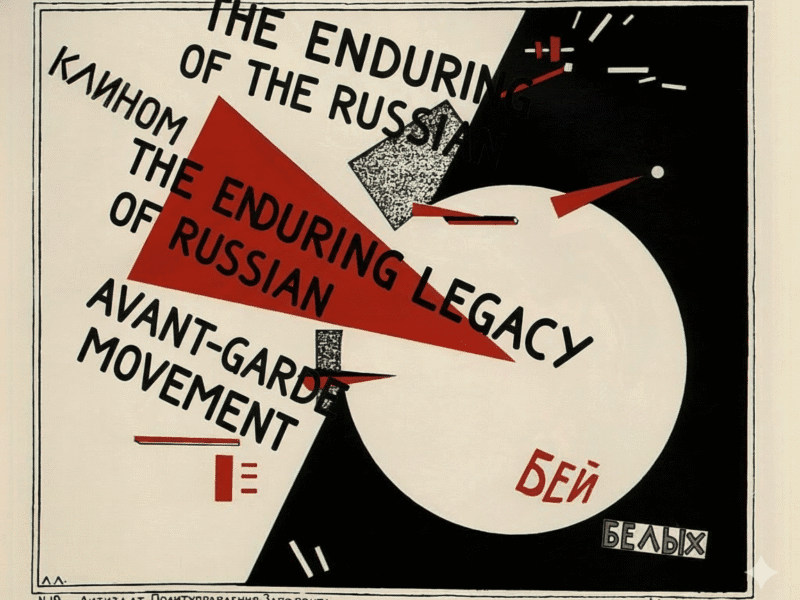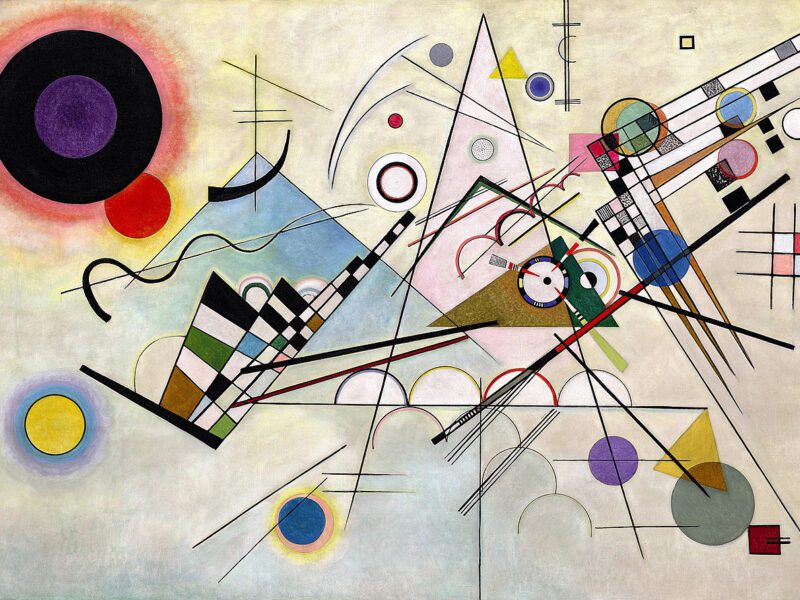Russian portraiture is more than a record of faces; it is a profound exploration of the human soul, a mirror to a nation’s turbulent history, and a vehicle for powerful storytelling. From the piercing psychological realism of the 19th century to the bold experiments of the Avant-Garde, Russian artists have used the portrait to capture the inner lives of their subjects and comment on the world around them. These paintings are not merely likenesses but complex narratives, encoding the social, political, and spiritual anxieties and aspirations of their time. They reveal a deep engagement with questions of identity, fate, and the very essence of the human condition, making Russian portraiture a unique and compelling chapter in the history of art.
Quick Answer
Russian portraiture uses storytelling to reveal the inner world of its subjects and reflect the nation’s cultural and political shifts. Artists like Ilya Repin and Ivan Kramskoi pioneered psychological realism to explore complex emotions and social commentary, moving beyond simple depiction. This tradition of narrative depth continued through the introspective works of the Silver Age and was later reshaped by the state-driven ideals of Socialist Realism. The core of this art form lies in its ability to tell a story about the individual’s place within the grander, often dramatic, Russian historical context.
What is Narrative Portraiture in the Russian Context?
In the context of Russian art, narrative portraiture refers to the practice of embedding a story within the depiction of a person. It moves beyond capturing a physical likeness to reveal the subject’s psychology, social standing, and relationship to contemporary events. Artists achieved this through the careful selection of setting, posture, expression, and symbolic objects. A portrait was not a static image but a scene from a larger drama, inviting the viewer to contemplate the life and circumstances of the person depicted. This approach was a direct departure from the idealized, formal portraiture favored by the European academies, aiming instead for a deeper, more resonant truth.
Historical Background: From Aristocracy to the People
The story of Russian narrative portraiture begins in the 18th century, heavily influenced by Western European styles. The earliest portraits were commissioned by the aristocracy and depicted figures of the court in a formal, often flattering manner. However, by the mid-19th century, a uniquely Russian identity began to emerge. This shift was accelerated by the social and political reforms of the era, including the emancipation of the serfs in 1861. A new artistic consciousness arose, one that sought to address the realities of Russian life and give voice to the common person.
This led to the formation of the Peredvizhniki (The Wanderers) in 1870. This group of artists broke away from the rigid State Academy of Arts in Saint Petersburg, determined to create art that was both realistic and socially relevant. They took their exhibitions to the provinces, making art accessible to a wider audience and focusing on subjects that reflected the full spectrum of Russian society, from peasants and clergy to intellectuals and revolutionaries. It was within this movement that the Russian tradition of the psychological portrait reached its zenith.
Key Characteristics of Russian Narrative Portraits
Russian narrative portraiture is defined by several distinct features that set it apart. These characteristics work together to create an image that is both a likeness and a story.
Psychological Realism
The most significant characteristic is an intense focus on the inner world of the subject. Artists like Ivan Kramskoi and Ilya Repin were masters of “psychological realism,” using subtle cues in expression and posture to convey complex emotions, moral dilemmas, and intellectual depth. Their goal was to paint not just the face, but the soul.
Social Commentary
Many portraits served as a form of social critique. By depicting individuals from all walks of life—from the destitute to the powerful—artists commented on social inequality, political corruption, and the spiritual state of the nation. Vasily Perov’s portraits of peasants, for example, are imbued with a quiet dignity that challenges the viewer’s preconceptions.
Use of Setting and Symbolism
The environment in which a subject is placed is never accidental. A cluttered study, a sparse room, or a dramatic landscape can provide crucial information about the person’s character, profession, and inner turmoil. Objects within the painting—a book, a piece of clothing, a specific tool—often carry symbolic weight, adding layers of meaning to the narrative.
Dramatic Tension
A sense of unresolved tension is palpable in many great Russian portraits. The subject often seems caught in a moment of intense thought or on the cusp of a significant decision. This dramatic quality engages the viewer, transforming them from a passive observer into an active participant in the story. Nikolai Ge’s Portrait of Leo Tolstoy (1884) shows the writer at his desk, not posing, but deep in the arduous process of creation, capturing the intellectual struggle central to his identity.
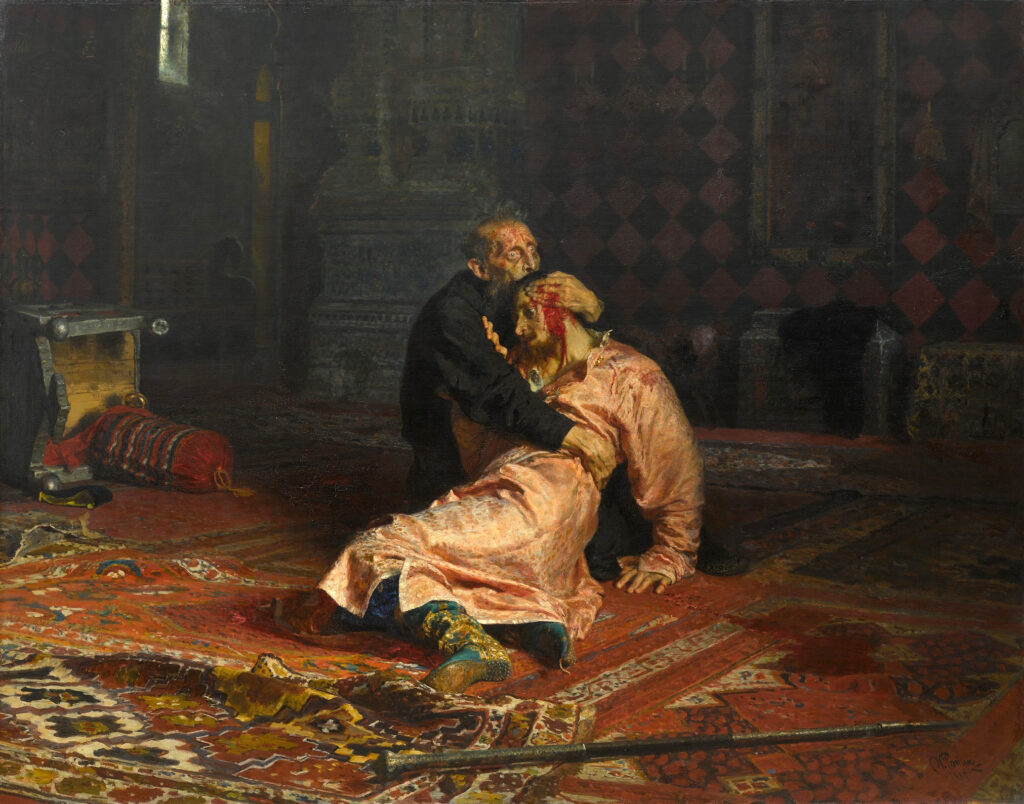
Major Figures and Their Defining Works
Several key artists are central to the story of Russian narrative portraiture. Their work exemplifies the movement’s core principles and pushed the boundaries of the genre.
Ivan Kramskoi (1837-1887)
A leader of the Peredvizhniki, Kramskoi was a master of the psychological portrait. His Portrait of an Unknown Woman (1883) is one of the most famous works in Russian art. The subject’s direct, confident gaze and elegant attire led to much speculation about her identity and moral standing, turning the painting into a commentary on female agency and social judgment in 19th-century Russia.
Ilya Repin (1844-1930)
Perhaps the most celebrated Russian realist, Repin created portraits that are astonishing in their emotional intensity and historical scope. His painting Ivan the Terrible and His Son Ivan on 16 November 1581 (1885) is a work of pure narrative horror, depicting the tsar cradling his dying son whom he has just struck in a fit of rage. It is a portrait of madness, remorse, and the tragic consequences of unchecked power. Another significant work, Portrait of Modest Mussorgsky (1881), was painted just days before the composer’s death from alcoholism; it is a brutally honest and deeply compassionate portrayal of human fragility.
Valentin Serov (1865-1911)
A student of Repin, Serov brought a lighter, more impressionistic touch to Russian portraiture, yet he never lost the focus on character. His early masterpiece, The Girl with Peaches (1887), is a portrait of Vera Mamontova, the daughter of a famous arts patron. The painting is filled with light and spontaneity, capturing the fleeting energy of youth. In contrast, his later portraits of aristocrats and artists, like the Portrait of Ida Rubinstein (1910), are stylized and monumental, reflecting the artistic shifts of the early 20th century.
💰 Did You Know?
When Ilya Repin displayed his painting of Ivan the Terrible, it caused a massive public scandal. Some viewers were so overcome by the raw violence and emotion of the scene that they wept or stood in stunned silence. The painting was even attacked with a knife by a mentally unstable man in 1913, and later by another individual in 2018, proving its narrative power remains potent over a century later.
Notable Works That Tell a Story
Beyond the major figures, many other portraits serve as powerful narrative examples. Each tells a unique story about an individual and their world.

Zinaida Serebriakova’s Self-Portrait at a Dressing Table (1909)
This joyful and intimate self-portrait by one of Russia’s foremost female artists tells a story of simple, domestic happiness. Serebriakova depicts herself smiling, surrounded by the tools of her toilet. The work is a celebration of femininity and personal contentment, a narrative that stood in stark contrast to the growing social and political anxieties of the pre-revolutionary period.
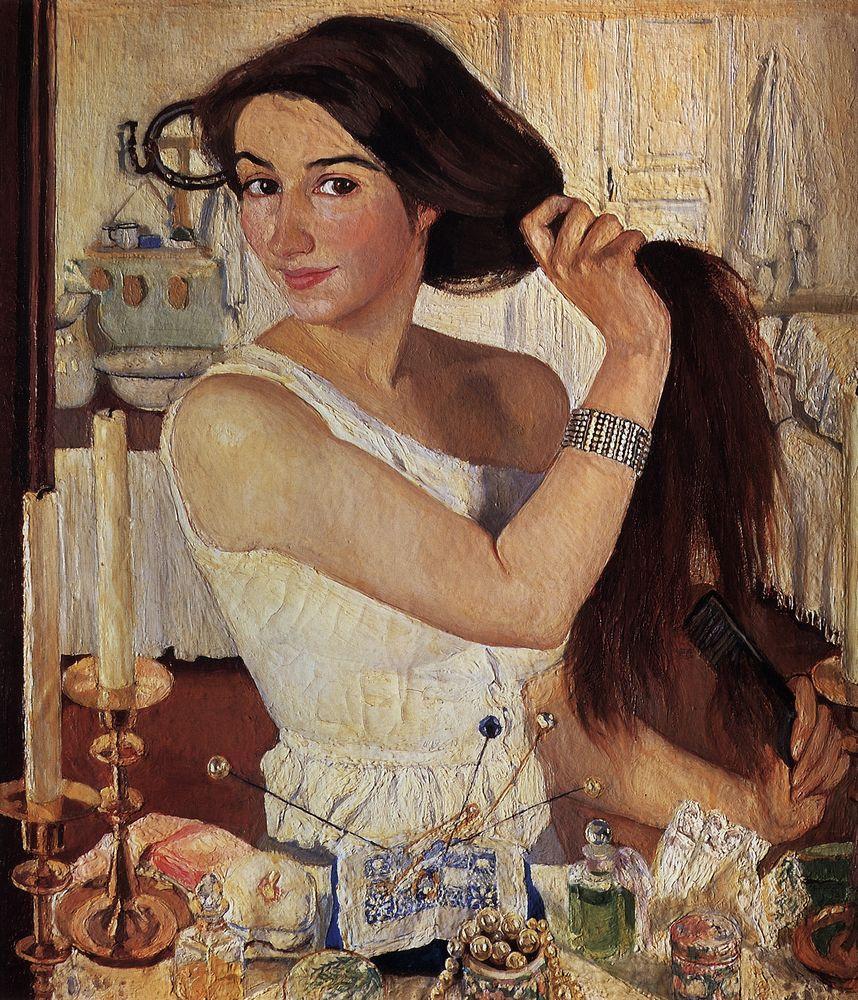
Boris Kustodiev’s Portrait of Fyodor Chaliapin (1921)
This larger-than-life portrait of the famous opera singer Fyodor Chaliapin tells a story of Russian spirit and cultural pride during a time of immense hardship. Painted shortly after the revolution, it depicts the flamboyant singer against a backdrop of a winter carnival. Despite the surrounding chaos, the portrait is a vibrant, optimistic narrative about the enduring power of Russian culture.
The Impact of the Russian Revolution and the Soviet Era
The Russian Revolution of 1917 marked a dramatic turning point. The experimental spirit of the Russian Avant-Garde, which had already begun to challenge realism with movements like Suprematism and Constructivism, initially flourished. Artists like Kazimir Malevich re-envisioned the portrait entirely, breaking it down into geometric forms.
However, by the 1930s, the state had consolidated its control over the arts, mandating Socialist Realism as the only acceptable style. Narrative in portraiture was no longer about individual psychology but about promoting a collective, idealized ideology. Portraits depicted heroic workers, wise leaders like Lenin and Stalin, and model citizens. While technically skilled, these works largely suppressed the deep, personal storytelling of the 19th century in favor of state-sanctioned propaganda. The narrative was no longer a question but an answer—a declaration of Soviet strength and progress.
![Kazimir Malevich, Black Square (c. 1915), Oil on linen, State Tretyakov Gallery, Moscow]](https://rus-art.com/wp-content/uploads/2025/10/Kazimir_Malevich_1915_Black_Suprematic_Square-1024x1024.jpg)
Legacy and Modern Relevance
The tradition of Russian narrative portraiture has a profound legacy. The emphasis on psychological depth and social consciousness has influenced generations of artists, both within Russia and internationally. The works of the Peredvizhniki, in particular, remain national treasures, housed in institutions like the State Tretyakov Gallery in Moscow and the State Russian Museum in Saint Petersburg. These collections stand as a testament to a time when art was a powerful tool for social change and human understanding.
In the contemporary world, the lessons of Russian narrative portraiture remain relevant. They remind us that a portrait can be more than a social media profile or a fleeting snapshot. It can be a deep, enduring story that connects us to the past and illuminates our shared humanity.
Common Misconceptions
One common misconception is that all 19th-century Russian art is dark and somber. While many works deal with difficult themes, artists like Valentin Serov and Zinaida Serebriakova created portraits filled with light, joy, and intimacy. Another misconception is that Socialist Realism completely erased the tradition of psychological insight. While its primary function was propaganda, some artists managed to embed subtle complexities and human emotion within the strict confines of the style.
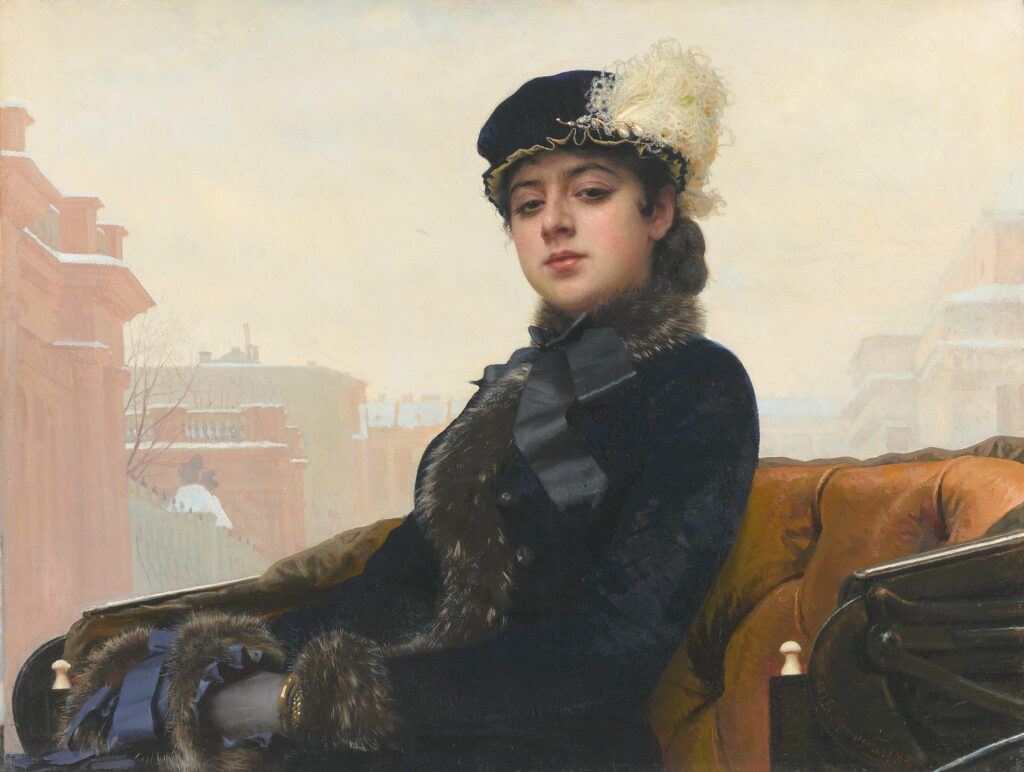
Essential Points About Narrative Power: The Storytelling Behind Russian Portraits
- Beyond Likeness: Russian portraiture prioritizes telling a story about the subject’s inner life and social context, not just capturing their physical appearance.
- Psychological Realism: Artists like Repin and Kramskoi were masters at conveying complex emotions and a deep sense of their subjects’ psychology.
- The Wanderers’ Influence: The Peredvizhniki (The Wanderers) movement was crucial in shifting the focus of art from academic idealism to the realities of Russian life.
- Social Commentary: Portraits often served as a vehicle for social critique, addressing issues of inequality, justice, and the human condition across all classes.
- Symbolism is Key: The setting, objects, and even clothing in a portrait are carefully chosen to contribute symbolic layers to the overall narrative.
- Revolutionary Shift: The Russian Revolution dramatically altered art, first with the abstraction of the Avant-Garde and later with the state-enforced ideology of Socialist Realism.
- Enduring Legacy: The great narrative portraits of the 19th century remain powerful cultural artifacts, celebrated in major institutions like the State Tretyakov Gallery.
- Art as a Mirror: Ultimately, the storytelling tradition in Russian portraits reflects the nation’s own turbulent history and its ongoing search for identity.
Frequently Asked Questions
Why are Russian portraits often so serious or intense?
The intensity in many Russian portraits, particularly from the 19th century, stems from the artistic movement of psychological realism. Artists were not interested in idealized or fleeting expressions. Instead, they sought to capture the “soul” of the individual, which often involved depicting deep contemplation, inner turmoil, or the weight of their life experiences. This approach was a reflection of the social and political climate of the time, which was fraught with profound questions about Russia’s future, social justice, and national identity, issues also explored in the great Russian novels of the era by authors like Dostoevsky and Tolstoy.
What was the main goal of the Peredvizhniki (The Wanderers)?
The main goal of the Peredvizhniki was to make art that was both truthful to Russian life and accessible to the general public. They rebelled against the strict, neo-classical curriculum of the Imperial Academy of Arts, which they felt was disconnected from the realities of the Russian people. Their mission was twofold: first, to create art with a strong national character that depicted ordinary people, Russian landscapes, and pivotal moments in Russian history with unflinching realism. Second, they organized traveling exhibitions (hence the name “Wanderers”) to bring this art directly to people in the provinces, fostering a wider appreciation for a distinctly Russian art.
How did the Russian Avant-Garde treat portraiture?
The Russian Avant-Garde, which flourished from roughly 1900 to the early 1930s, radically deconstructed traditional portraiture. Instead of focusing on realistic depiction and psychological narrative, artists like Kazimir Malevich (Suprematism) and Vladimir Tatlin (Constructivism) explored the fundamental elements of form, color, and composition. For them, the goal was not to tell the story of a person but to create a new artistic language for a new society. Portraits became abstract, fragmented, and geometric. The subject was often a starting point for an experiment in visual perception rather than an exploration of character, a complete break from the realist tradition.
What is the most famous Russian portrait?
While it’s difficult to name a single “most famous” work, Ivan Kramskoi’s Portrait of an Unknown Woman (1883) is certainly one of the most iconic and recognizable paintings in all of Russian art. Housed in the State Tretyakov Gallery, its fame comes from its technical brilliance and its enduring mystery. The subject’s direct and slightly disdainful gaze, combined with her fashionable attire, broke from traditional depictions of women. She is not demure or idealized but confident and challenging. The refusal to name her has fueled endless speculation, turning the portrait into a powerful statement about female identity and social conventions in 19th-century Russia.
Did female artists play a significant role in Russian portraiture?
Yes, though they faced more obstacles than their male counterparts, several female artists made significant contributions. The most prominent is Zinaida Serebriakova (1884-1967). Her works, especially her early self-portraits and portraits of her children, are celebrated for their warmth, intimacy, and masterful technique. Unlike the heavy social dramas often depicted by the male Wanderers, Serebriakova’s narratives frequently revolved around domestic life, personal joy, and the beauty of the everyday. Her Self-Portrait at a Dressing Table (1909) is a landmark work that presents a confident, modern woman and a talented artist at the height of her powers.
How did Socialist Realism change the story of portraiture?
Socialist Realism fundamentally changed the narrative of portraiture from one of personal, psychological exploration to one of collective, public ideology. Under Soviet rule, art was required to be “realistic in form and socialist in content.” This meant portraits were no longer about capturing individual doubt, complexity, or struggle. Instead, they were designed to tell a story of an idealized Soviet state. Subjects were depicted as heroic, optimistic, and dedicated to the cause of communism. Portraits of leaders like Stalin were meant to convey wisdom and strength, while portraits of factory workers and farmers celebrated labor and conformity. The individual’s story was replaced by their role in the state’s grand narrative.

